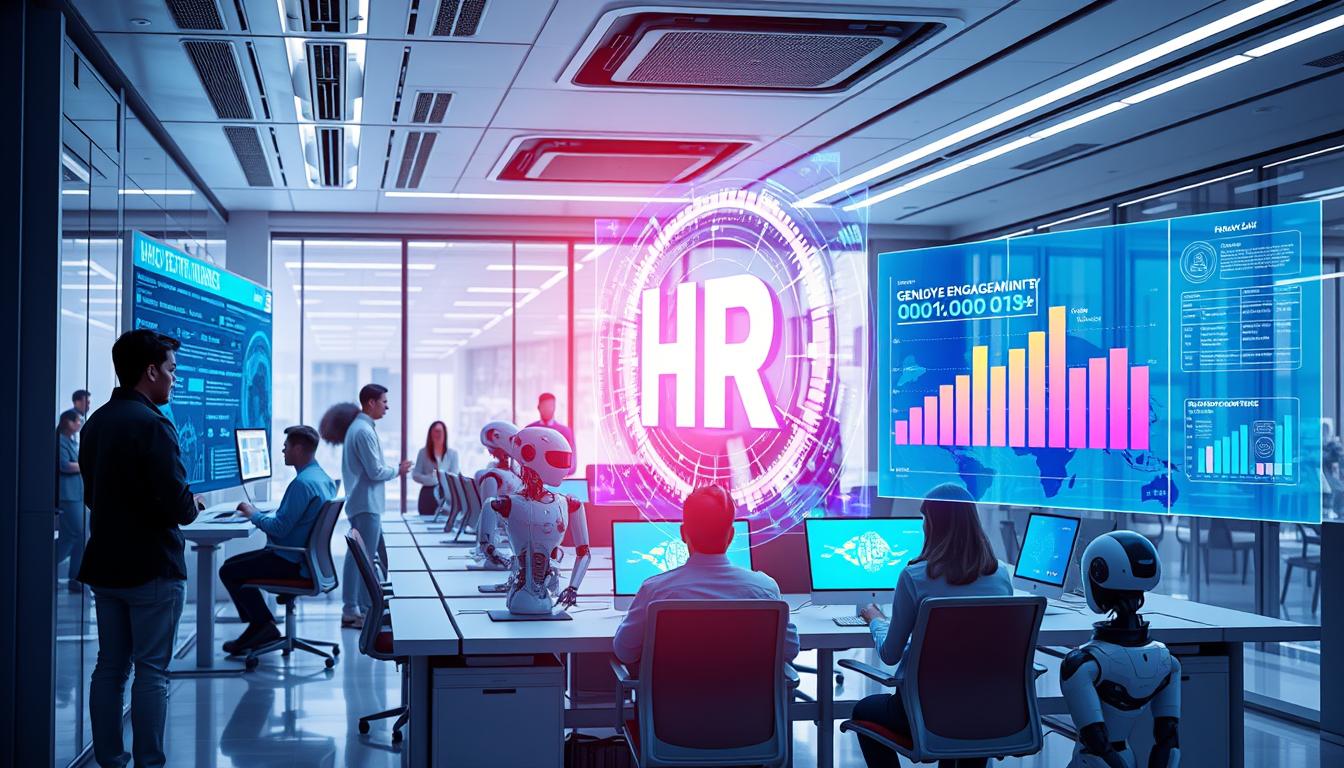Last Updated on December 9, 2025
The landscape of employee benefits is witnessing a significant transformation. As Future Employee Benefits become integral to organizational strategies, companies must adapt their offerings. Employee wellness programs and workplace perks are crucial in enhancing employee satisfaction and retention. Additionally, career development opportunities that resonate with the evolving workforce are key to drawing in top talent. Given that benefits can account for up to 30% of total compensation, their evolution is paramount for both employers and employees.
Key Takeaways
- The significance of employee benefits has grown, accounting for up to 30% of total compensation.
- Welfare capitalism laid the groundwork for modern benefits in the late 19th century.
- Recent trends show a shift towards customizing employee benefits to cater to individual needs.
- Employee wellness programs are becoming increasingly integrated into benefits packages.
- Career development opportunities are vital for both retention and job satisfaction.
- The rise of flexible and remote work has prompted changes in benefits design.
The Historical Context of Employee Benefits
The evolution of employee benefits offers deep insights into the development of workplace practices. These benefits have adapted to economic pressures and societal shifts, highlighting their vital role in keeping a workforce productive. The origins of welfare capitalism and their impact on historical employee benefits show the intricate nature of employer-provided benefits today.
Welfare Capitalism in the Late 19th Century
In the late 19th century, welfare capitalism emerged as companies acknowledged the need to enhance workers’ welfare to counteract industrialization’s harsh conditions. The Granite Cutters Union initiated the first national sick benefit program in the U.S. in 1877, setting a precedent for various support programs. This move established a structure for employer-provided benefits, going beyond just wages.
The Impact of the Great Depression on Benefits
The Great Depression created a pressing need for social safety nets, leading to the Social Security Act of 1935. This act introduced widespread pension systems to support retired workers, marking a pivotal shift towards long-term financial security. The economic pressures of that era highlighted the importance of employer-provided benefits, as companies realized comprehensive support could enhance loyalty and reduce turnover.
Post-War Developments in Employer-Provided Benefits
Post-World War II, the employer-provided benefits landscape underwent significant changes. Wage freezes led to an increase in employer-based group health insurance. In 1954, the Internal Revenue Code allowed employers to deduct contributions towards employee health insurance, making it more appealing for employers and employees alike. The introduction of Medicare and Medicaid in the 1960s further shaped employer-provided health insurance, creating a broader support system for American workers.
The Importance of Employee Benefits in Today’s Workplace
In today’s fast-paced job market, employee benefits are crucial for boosting job satisfaction and retaining employees. As the workforce changes, knowing what employees want helps companies craft benefits packages that meet their needs.
Significance of Benefits for Employee Retention
Attractive benefits are key to keeping employees. Last year, 47.8 million people left their jobs, highlighting the importance of effective retention strategies. Companies offering comprehensive benefits tend to hold onto their talent. For example, 60% of employees say benefits are a major factor in deciding to stay with their employer. Flexible work, healthcare, and retirement plans are often top priorities.
How Benefits Contribute to Job Satisfaction
Employee benefits are a major driver of job satisfaction. Studies show that 90% of employees see health benefits as vital. Flexibility and paid time off are also highly prized, showing that employees want a balance between work and life. To improve job satisfaction, companies should focus on benefits like mental health support, telemedicine, and retirement plans. Interestingly, 81% of employees consider benefits a key factor when choosing a job, underscoring the importance of offering competitive benefits.

Shifts in Workplace Dynamics
The workplace is transforming significantly, driven by evolving employee expectations and shifts in power dynamics. A move from fear-based to inclusive, human-centered cultures is reshaping how organizations function. Leaders focusing on employee well-being, growth, and fulfillment see higher retention rates and create positive environments where individuals feel valued.
Evolving Power Dynamics Between Employers and Employees
Today’s workforce experiences a democratized talent marketplace, altering power dynamics within organizations. Employees now take more control over their career paths, seeking environments that value appreciation, trust, and growth opportunities. Over 50% of employees returning to full-time office work want remote options, showing flexibility is key to job satisfaction. In this new landscape, engaging employees by listening to their voices is more important than ever.
The Role of Employee Expectations in Benefits Design
As employee expectations change, so must the design of benefits. Organizations adopting a human-centric culture offer benefits that meet diverse needs. Surveys show that innovative benefits, like personalized training and hybrid work options, strengthen employee connections and improve workplace relationships. Focusing on social interaction and community can lead to better employee experiences and higher retention. Employees value environments that match their social and professional values.
Future Employee Benefits: Trends to Watch
The employee benefits landscape is undergoing a significant transformation, mirroring the changing needs and expectations of today’s workforce. At the forefront of this shift is personalization, as benefits packages become more tailored to individual preferences. This evolution not only makes benefits more appealing but also crucial for enhancing employee well-being. Additionally, the trend towards flexible work arrangements is gaining prominence, catering to employees’ desires for a better work-life balance.
Personalization and Customization in Benefits Packages
Organizations are adapting to the complexities of the modern workforce by embracing customizable benefits packages. Employees value the ability to choose benefits that align with their unique circumstances and life stages. For instance, a younger employee might prioritize support for student loan repayment, while a parent may seek robust childcare options. This personalization not only boosts engagement but also highlights a commitment to employee well-being.
Increased Focus on Employee Well-Being and Mental Health
Employers are redefining their approach to benefits, extending beyond traditional offerings. There is a growing emphasis on employee well-being, leading to the expansion of health and wellness programs. These now include comprehensive mental health support alongside physical wellness initiatives. Research indicates a strong link between mental health and productivity. Hence, employers increasingly recognize that a healthy team is a productive team.
Flexible Work Arrangements as a Core Benefit
The demand for flexible work arrangements is on the rise. A significant majority of virtual teams wish to maintain remote work as a permanent option. Innovative schedules, such as a four-day work week, are attracting employees seeking balance and flexibility. This approach not only boosts job satisfaction but also improves overall employee well-being by allowing individuals to better manage their personal and professional lives.

The Role of Technology in Shaping Benefits
Technology is revolutionizing employee benefits, making them more efficient and personalized. AI and automation are key to this transformation, simplifying complex processes. This shift is crucial for employers, setting the stage for technology to become integral to benefits management.
AI and Automation in Benefits Administration
AI is changing the game in benefits administration, from enrollment to claims processing. Automation cuts down on delays, ensuring quicker and more accurate handling of employee data. This leads to better decision-making and more effective use of resources in healthcare and benefits.
As technology evolves, expect benefits to become more tailored to individual needs. This means health and benefits programs will better match what employees want, improving their overall satisfaction.
Consumerization of Employee Benefits
Employee expectations for benefits are shaped by their consumer experiences. Today, workers want clear, personalized benefits, similar to what they find in shopping. They look for transparency and easy access to information, often using technology to explore their options.
Companies must innovate to meet these needs, offering benefits that speak to each employee on a personal level. This approach boosts job satisfaction and loyalty.
Employee Wellness Programs: A Crucial Component
The work environment is evolving, making employee wellness a key focus for companies. They’re now introducing wellness programs that cover physical, mental, and emotional health. This move underscores the value of holistic health support in boosting productivity and job satisfaction.
Importance of Holistic Health Support
Despite just 18% of employees feeling supported in managing their mental health, the demand for robust employee wellness efforts is critical. With 46% of workers finding their jobs too stressful, stress can cause burnout, increasing the likelihood of job searching by 2.6 times. Adding mental health tools to wellness programs fosters a safer psychological work environment. An overwhelming 87% of employees want their employers to support their mental health, showing a clear need for a better work culture.
Future Perspectives on Wellness Programs
Wellness programs are set to become more flexible and supportive. With 67% of employees recommending workplaces with wellness initiatives, their impact on retaining staff is evident. Flexible schedules or work breaks can greatly enhance morale and productivity. Moreover, companies investing in holistic health support see an average ROI of $3.27 for every dollar spent. As over 50 million U.S. workers benefit from workplace wellness programs, it’s evident these initiatives are vital for both employee well-being and corporate success.
Retirement Savings Plans and Financial Security
Planning for retirement is crucial for long-term financial stability. Over the years, there’s been a notable shift from traditional pensions to 401(k) plans. This change reflects workers’ preference for the flexibility and mobility that 401(k) plans provide. It ensures their retirement savings can grow despite job changes throughout their careers.
Shift from Traditional Pensions to 401(k) Plans
401(k) plans have gained popularity due to their focus on personal responsibility for retirement savings. They allow you to save a part of your income on a tax-deferred basis, which means your contributions can increase over time. Many employers boost your savings by matching your contributions, significantly enhancing your retirement funds. Given that retirement could last 30 years or more, having a strong savings plan is essential.
Importance of Financial Literacy and Planning Resources
While it’s crucial to have access to 401(k) plans, knowing how to maximize their benefits is equally vital. Many employees struggle with financial stress, with 57% citing money as their main worry. Understanding financial literacy empowers you to make better decisions about your retirement savings. Employers can greatly assist by offering resources and tools for navigating your financial future. Starting with just $50 monthly can grow to about $23,218 over 20 years, significantly boosting your retirement savings.
Think about the long-term advantages of regularly contributing to your 401(k) plan. With an effective plan, securing your finances in retirement becomes attainable. 
The Shift Towards Inclusive Benefits
The modern workplace is undergoing significant changes, with evolving expectations around employee benefits. Organizations now aim for inclusivity, recognizing the need for benefits that cater to diverse demographics and generations. This approach boosts employee satisfaction and supports a diverse workforce.
Addressing Diverse Needs Across Generations
Today’s workforce includes employees from various generations, each with distinct needs and perspectives. Inclusive benefits help organizations meet these diverse requirements. For instance, flexible scheduling and hybrid work models support those who prefer remote work. A recent survey showed that 40% of employees prefer working remotely or in a hybrid setup over returning to the office full-time.
Employers must also ensure health insurance covers LGBTQIA dependents, non-married partners, and specific healthcare needs like fertility treatments or gender confirmation surgery. This inclusivity is crucial for a diverse workforce.
Importance of Caregiving Resources and Family Benefits
Caring for family members can significantly impact employees’ work-life balance. Employers can support their staff by offering comprehensive caregiving resources and family benefits. Benefits like fertility treatments and adoption support promote family well-being.
Including paid parental leave for all parents shows a commitment to supporting family life. This approach creates a supportive work environment that values family.
Employers can also consider matching employee contributions to Health Savings Accounts (HSAs) and Flexible Spending Accounts (FSAs). These options allow employees to set aside pre-tax dollars for medical costs, dependent care, and transportation. Such benefits address the financial needs of diverse families, enhancing employee retention and fostering a more engaged workforce.
Conclusion
The future of employee benefits is marked by a shift towards a proactive and adaptable approach. With 83% of employees seeing their benefits as crucial, companies must focus on strategic management to boost engagement. This means not just meeting basic needs but also catering to diverse employee preferences.
Research shows that 92% of employees consider benefits key to job satisfaction. Many will weigh job offers based on the benefits they receive. Offering a comprehensive, customizable benefits package can attract and retain talent, often without the need for high salaries. Features like flexible work arrangements and wellness programs are vital for a supportive workplace culture.
In today’s competitive job market, adapting to evolving employee needs is crucial. The future of employee benefits will likely include mental health support and flexible leave policies. By recognizing that a thoughtful, inclusive benefits strategy drives engagement, employers can build a loyal, motivated workforce. For insights on adapting to the future workplace, visit this resource.








